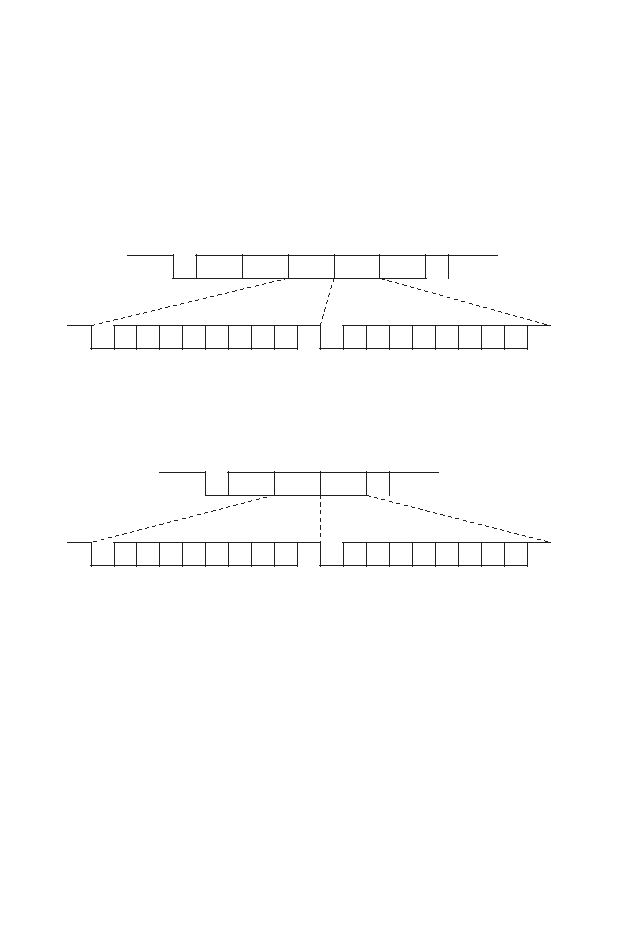- 您现在的位置:买卖IC网 > Sheet目录2002 > LICAL-TRC-MT (Linx Technologies Inc)IC TRANSCODER MT BI-DIR 20-SSOP

–
20
Serial Output
Upon reception of every valid packet, the transcoder outputs a serial data
stream containing information about the transmission. The information
takes two forms depending on the User Access setting.
If the User Access is set to open, then the serial output consists of a start
byte, the three byte address of the transmitting device, a status line byte, a
custom data byte and a stop byte. The start byte is 0x00 and the stop byte
is 0xFF.
If the User Access is set to locked, then the serial output consists of a start
byte, TX ID byte, status line byte, custom data byte and a stop byte. The
start byte is 0x00 and the stop byte is 0xFF.
The status line byte reflects the states of the status lines, ‘1’ for high
and ‘0’ for low. This represents the current logic states of the outputs,
not the command that was received, so that the states of latched lines
are correctly represented. Line D0 corresponds to bit b0 in the byte, D1
corresponds to b1, and so forth. This allows applications that use an
embedded microcontroller to read the transmitted commands without
having to monitor eight hardware lines.
The TXID and Custom Data bytes are described in their own sections.
The bytes are output asynchronously least significant bit first with one
start bit, one stop bit, and no parity at the baud rate determined by the
SEL_BAUD line. During normal operation, the SER_IO line is an input,
start
stop start
stop
SER_IO
00
ADR 3
STATUS CUSTOM
FF
b0 b1 b2 b3 b4 b5 b6
b6
b7
b0 b1 b2 b3 b4 b5
ADR 1
ADR 2
Figure 15: MT Series Transcoder Open Access Serial Output
start
stop start
stop
SER_IO
00
TX ID
STATUS CUSTOM
FF
b0 b1 b2 b3 b4 b5 b6
b6
b7
b0 b1 b2 b3 b4 b5
Figure 16: MT Series Transcoder Locked Access Serial Output
发布紧急采购,3分钟左右您将得到回复。
相关PDF资料
LT1331CNW#PBF
IC TXRX 5V/3V RS232 28-DIP
LT1341CG#TRPBF
IC TXRX 5V RS232 SHUTDOWN 28SSOP
LT1342CG
IC TXRX 5V RS232 W/3VLOGC 28SSOP
LT1794CSW#PBF
IC OPAMP 200MHZ DUAL 20-SOIC
LT6301IFE
IC XDSL LINE DRIVER DUAL 28TSSOP
LT8500IUHH#TRPBF
IC PWM GENERATOR 56-QFN
LTC1096IN8#PBF
IC A/D CONV 8BIT SRL IN/OUT 8DIP
LTC1099ACN#PBF
IC A/D CONV 8BIT HI-SPEED 20-DIP
相关代理商/技术参数
LI-CAM-AR0331
功能描述:视频模块 Aptina AR0331 HD WDR CAMERA BOARD
RoHS:否 制造商:Leopard Imaging 产品:Camera Modules 支持的视频格式:H.264, MPEG4, MJPEG 每秒帧数:30 显示分辨率—像素:1920 x 1080 接口类型:RS-485, USB 工作电源电压:12 V 最大工作温度:+ 45 C 尺寸:113.3 mm x 57.6 mm x 32.2 mm
LI-CAM-AR0331-324-1.8
功能描述:视频模块 Aptina AR0331 IP CAMERA BOARD
RoHS:否 制造商:Leopard Imaging 产品:Camera Modules 支持的视频格式:H.264, MPEG4, MJPEG 每秒帧数:30 显示分辨率—像素:1920 x 1080 接口类型:RS-485, USB 工作电源电压:12 V 最大工作温度:+ 45 C 尺寸:113.3 mm x 57.6 mm x 32.2 mm
LI-CAMFLEX
功能描述:程序设计器配件 2" CAMERA EXTENSION CABLE RoHS:否 制造商:Lattice 产品:ispDOWNLOAD Cables 用于:In-system Programming
LI-CAM-IMX036
功能描述:视频模块 Sony iMX036 HD IP CAMERA BOARD
RoHS:否 制造商:Leopard Imaging 产品:Camera Modules 支持的视频格式:H.264, MPEG4, MJPEG 每秒帧数:30 显示分辨率—像素:1920 x 1080 接口类型:RS-485, USB 工作电源电压:12 V 最大工作温度:+ 45 C 尺寸:113.3 mm x 57.6 mm x 32.2 mm
LI-CAM-IMX036-1.8
功能描述:视频模块 Sony IMX036 IP CAMERA BOARD
RoHS:否 制造商:Leopard Imaging 产品:Camera Modules 支持的视频格式:H.264, MPEG4, MJPEG 每秒帧数:30 显示分辨率—像素:1920 x 1080 接口类型:RS-485, USB 工作电源电压:12 V 最大工作温度:+ 45 C 尺寸:113.3 mm x 57.6 mm x 32.2 mm
LI-CAM-IMX104-1.8
功能描述:视频模块 Sony IMX104 IP CAMERA BOARD
RoHS:否 制造商:Leopard Imaging 产品:Camera Modules 支持的视频格式:H.264, MPEG4, MJPEG 每秒帧数:30 显示分辨率—像素:1920 x 1080 接口类型:RS-485, USB 工作电源电压:12 V 最大工作温度:+ 45 C 尺寸:113.3 mm x 57.6 mm x 32.2 mm
LI-CAM-IMX104-P33
功能描述:视频模块 Sony IMX104 IP CAMERA BOARD
RoHS:否 制造商:Leopard Imaging 产品:Camera Modules 支持的视频格式:H.264, MPEG4, MJPEG 每秒帧数:30 显示分辨率—像素:1920 x 1080 接口类型:RS-485, USB 工作电源电压:12 V 最大工作温度:+ 45 C 尺寸:113.3 mm x 57.6 mm x 32.2 mm
LI-CAM-IMX122-P33
功能描述:视频模块 Sony IMX122 IP CAMERA BOARD
RoHS:否 制造商:Leopard Imaging 产品:Camera Modules 支持的视频格式:H.264, MPEG4, MJPEG 每秒帧数:30 显示分辨率—像素:1920 x 1080 接口类型:RS-485, USB 工作电源电压:12 V 最大工作温度:+ 45 C 尺寸:113.3 mm x 57.6 mm x 32.2 mm